My pal MikeM is fond of saying that the whole point of enduring our adult jobs is to get to the point where we are free and able to engage in interesting projects with great people in fun places. Such is the case with VIRTUOSO, my in-process book about the tool cabinet and work bench of Henry O. Studley.
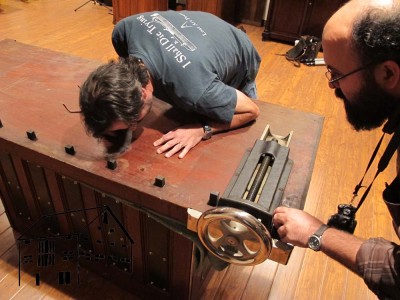
Collaborating with photographer Narayan Nayar and editor/publisher Chris Schwarz is an ongoing delight. The project patron and owner of the Studley ensemble is a man of astonishing accomplishments and insights whose company I relish. Our work setting within his menagerie is about the most wonderful work environment I have ever experienced as an aesthete and artifactualist. This definietly fits the description of what MikeM describes as the point of work.
Immediately after wrapping up WIA in Cincinnati we loaded up the car and headed to North Tulsapolis, Montaska for my fifth visit to the collection for our final scheduled session of photography. What made this trip extra special was that on this time we would be joined by vise maven Jameel Abraham to provide me another set of expert and experienced eyes in my final examination of the vises on Studley’s bench before I ramp up weaving all the research into a compelling book.
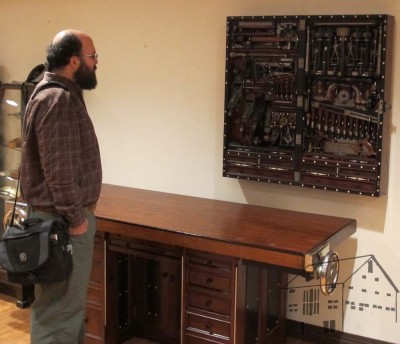
As is usually the case, Jameel’s reaction to the ensemble was stasis. He stared for several minutes before I cajoled him into the work at hand.
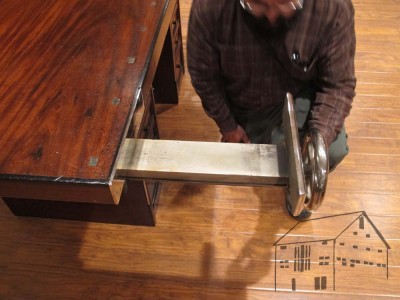
Like me and all who have witnessed this before him, Jameel was much impressed by a face vise that opened 16″ with zero wiggle. I mean zero.
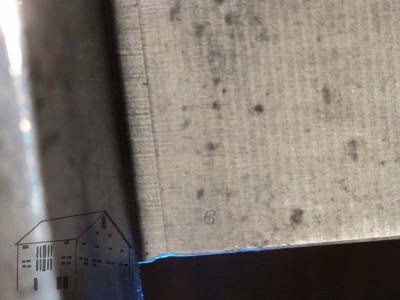
The information in just this image is worth many thousand words of description.
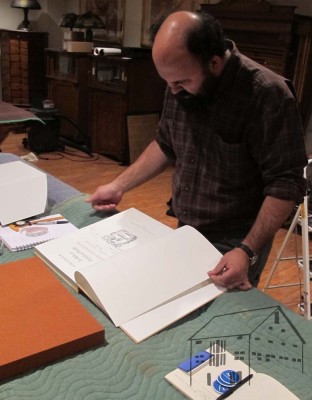
Finally, after some pathetic nagging from me, he opened his copy of the Deluxe Edition. His silent smile was gratifying.
Yup, interesting projects, great people, fun places.
About a month ago, a mere three weeks before I was set to leave for Woodworking in America, I received a note from Jay Christian, Program Chair for the Washington Woodworker’s Guild, reminding me of my presentation to them on the evening of October 15. Immediately I checked my calendar and smacked my forehead. I enjoy presenting to the Guild and have done so close to a dozen times over the decades, but this one presented some scheduling problems.
The evening for my scheduled presentation coincided with my plans for packing so that I could depart for Cincinnati the next morning. Given the late date of the reminder, I felt there was no way I could ask the Guild to reschedule and so I simply proceeded with the presentation as scheduled.
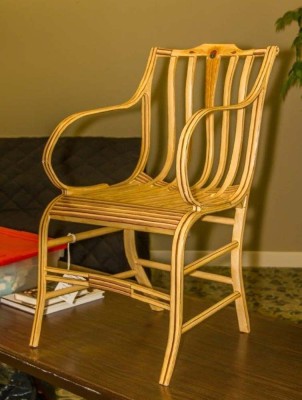
My topic for the evening was the steam bending of parts for the construction of the Gragg elastic chair, one of the favorite research projects from my nearly three decade long career at the Smithsonian Museum Conservation Institute. I’d shown the chair at a previous meeting’s “Show and Tell”, and they invited me back to show exactly how I was doing it. I will be blogging extensively about the two Gragg chairs I am building over the winter.
Much to my delight my protégé Daniela was able to arrange for her husband to watch little Pedro so she could attend. That was exceedingly helpful as she and I had worked out a choreography for the necessarily rapid forming of these complex parts.
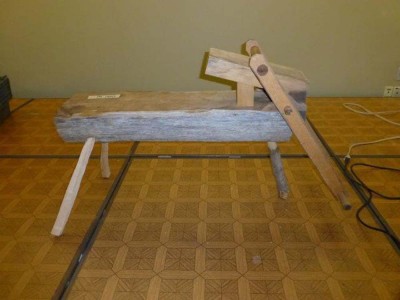
A demo of this type requires a large inventory of materiel, tools, and devices, including my petite bodger’s shaving horse built from a recycled half log that used to be a door header from a log barn and a variety of scraps from the wood pile.
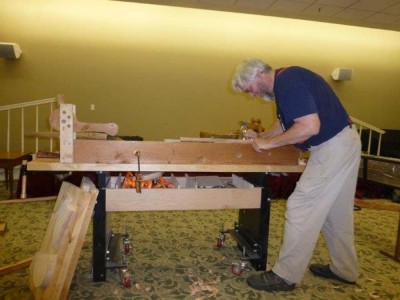
Another favorite fixture is my shaving beam that can be clamped to a work surface. The beam has a mondo cam clamp at one end and a tiny wood screw at the other, so I have a lot of flexibility to either pull or push a tool against the work piece. It is a genuine favorite accessory, and is used extensively when preparing the stock for steam bending.
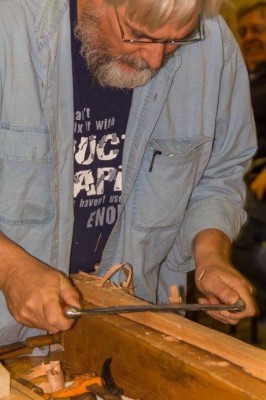
I covered a wide range of topics including harvesting, and demonstrating splitting, and riving, shaving, and planing the oak stock.
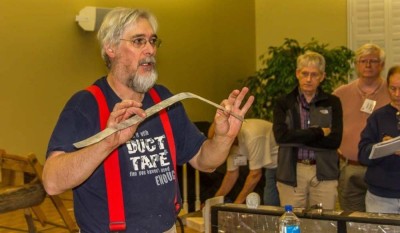
The tight serpentine form of the major side element for the chair — it begins at the crest rail of the back and ends as the front foot — requires bending straps to help everything bend without breaking.

Once the piece has cooked properly, in this case for about 20 minutes once the steam chamber gets to proper temperature (about 180 degrees or a bit more) out it comes. It is as hot as you would expect, and often I use welding gloves.
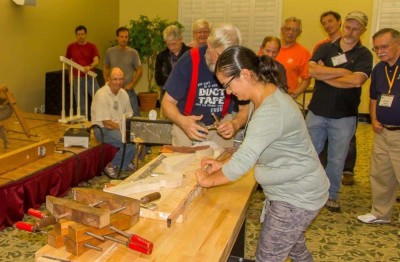
To make things move more quickly I marked out the locations for the straps on either side of the element, and we quickly clamp them in place with Vice Grips. We only have about 60 seconds to get everything done. We almost hear the clock ticking in our brains as we get going.
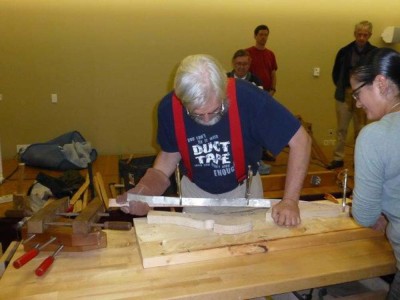
At thirty seconds I’d better be wrapping up the first curve, setting up for the opposing second curve. Haste is not helpful if it is jerky. I have to work steadily but quickly.
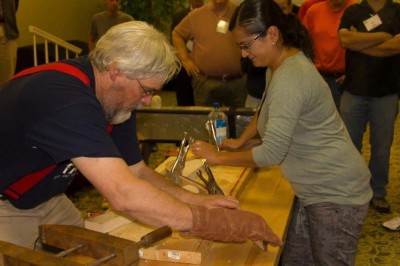
By the 45 second mark I need to be working on the second of the serpentine bends.
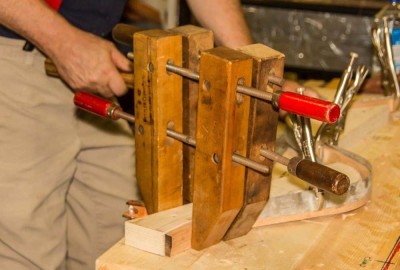
The last step is to tighten the wood screws that inflict the return sweep onto the bottom of the front leg at the 60 second mark.
Done! This bend went perfectly.
While I had hoped for a 9PM conclusion, between my longwindedness and the audience’s enthusiasm it was more like 10.30 before we got all wrapped up and on the road, and 2.30 Wednesday morning before pulling up at the cabin. The next morning we unloaded, reloaded, and spent nine hours driving through the rain to Cincinnati.
Photos courtesy of Barry Ingram and Joel Jacobson
Mark your calendar for July 24-26, 2014, and note the location of Avoca NY. It’s never too early to plan or set the date aside.
We are living in a golden age of tools. New woodworking tools, from the legion of gifted makers ranging from comparatively large concerns like Lee Valley or Lie-Nielsen to small makers like Raney Nelson or Lee Marshall or The Brothers Abraham, with scores of others populating the toolism landscape, are widely available for a fair price. And vintage tools? I don’t have to look too hard there, either, with wallet-vampires Patrick Leach and Martin J. Donnelly hovering in my consciousness on a nearly perpetual basis.
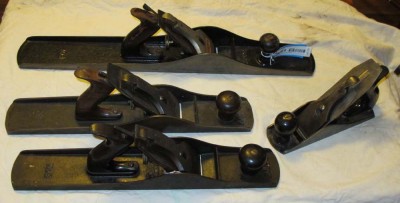
One of the year’s highlights is Martin’s “warehouse clearance” auction in July, where everything that has not been in the past year’s scheduled auctions gets sold off in three days, usually with about 3,000 lots. One advantage to this sale is the higher proportion of “user tools” vs. “collector tools.” There’s plenty of both, and sometimes startlingly good deals can be found.
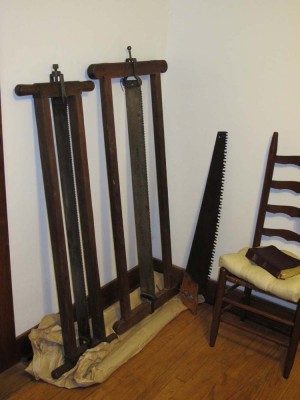
Here is part of my haul from the last time I went, including two magnificent four-foot hand-forged-blade veneer frame saws. The large one was the only tool I was determined to bid on, the second was as surprise I had overlooked in the listing. Given the final hammer price, apparently everyone else overlooked it also.
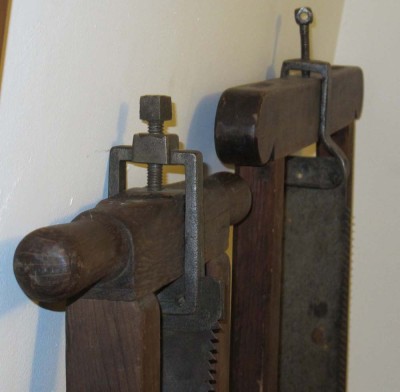
Even if you do not buy anything, a great time of fellowship and tool-gawking awaits you. See you there.
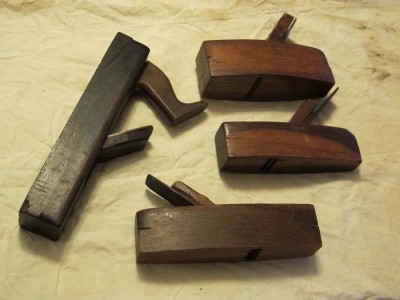
When I walked into the room Sunday morning fifteen minutes before my 9AM starting time it was already almost full, and folks were bringing more chairs from somewhere else, and a ring of people standing began to form around the perimeter of the space.
Now this is standing room! 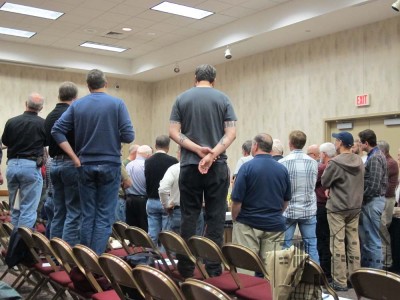
Who says woodworkers don’t want to learn finishing?
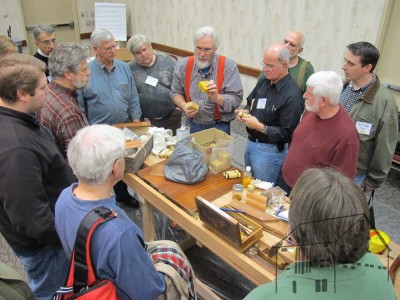
It is a personal quirk but every time I prepare for a talk when I have been granted a generous time slot, invariably I say to myself, “There’s just no way I have anything to say for that long.”
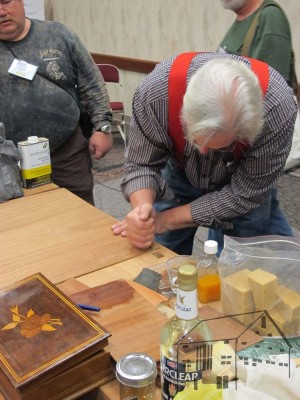
But once I get started, and I really enjoy demonstrating up close and personal, coiffure be damned, and on occasion a spectator gets splashed with something. I guess I should warn them to dress like I do, then they would not have anything to worry about.
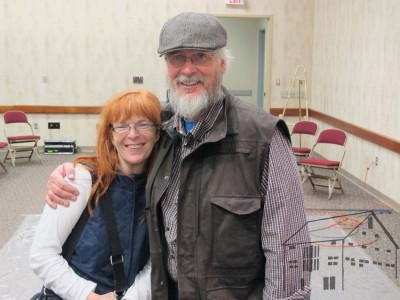
After running over the allotted time by almost an hour I packed up, said goodbye to friends, and headed down the road for another week of photography and study of the H.O. Studley tool cabinet.
I was scheduled to be on stage first thing Saturday morning, starting at 8.30. I was somewhat concerned about the long-ish time slot of 8.30 – 12.30 for my talk “The Transition From Hand Tools to Machines” since I had given a version that before and it was only about 75 minutes long. Megan thought I might start at 9, add a bit more information, and have some Q&A and that way maybe fill up two hours.
Even while driving in to the Convention Center it was apparent that this plan would not work. At about 8.20 Megan called and said “The crowd is here and they are restless.” Fortunately I was just pulling into the parking garage and was at my appointed place at my appointed time.
In fact the expanded time slot allowed me to explore many of the topics in much greater detail than before, and even after a halftime break the audience remained large and attentive. Wilbur Pan posted a concise if tongue-in-cheek review of the session here.
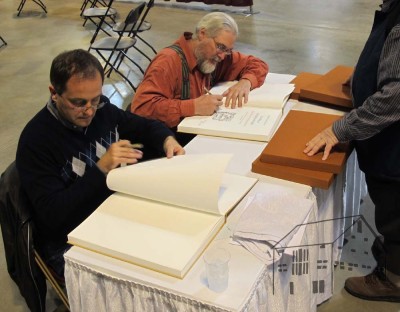
Three-plus hours later I stopped talking and made my way down to The Marketplace where Philippe Lafargue and I were to go on display and spend the afternoon signing hundreds of copies of To Make As Perfectly As Possible: Roubo On Marquetry. After a quick lunch we took our stations at a table adjacent to the Lost Art Press booth and met the long line of folks waiting patiently for our signatures.
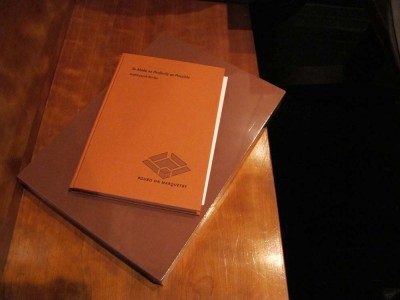
The book’s Standard Edition is something like 9×12 inches, and the Deluxe Edition twice as big, which means we were wrangling a lot of awkward poundage of books, signing until our arms nearly fell off. We were quite literally taken aback by the enthusiasm and encouragement of the crowds patiently waiting in line to spend time with us.
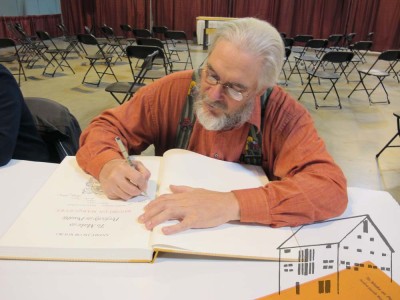
It was a serious time of celebration and delight, and the only way it could have been better if our collaborator Michele Pagan had been able to join us as well. Her absence due to an unavoidable previous commitment was noted by everyone.
Late in the afternoon I returned Philippe to the airport for his flight home, promising each other to get together sooner than another decade, then concluded the evening at a raucous celebration at the Schwarz household. Bed could not come soon enough after that.
The first day of WIA on Friday was somewhat unusual for me as I was able to swim anonymously in the sea of woodworking as just another fish in the school.

Given my decades-long interest in and practice of marquetry it is surprising that I had never met marquetry maestro Silas Kopf before, but I rectified that shortcoming at the conclusion of his first session that day. Silas is a true artist with veneers, and it was fascinating to see and listen as he composed and constructed a floral marquetry pattern. His approach is nearly opposite of my own so it was a fertile learning experience for me.
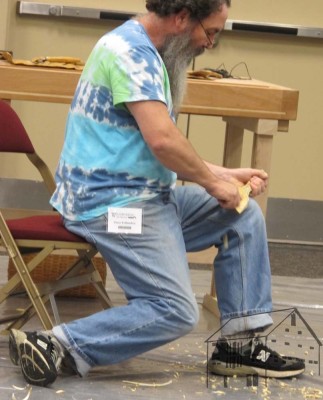
I next attended Peter Follansbee’s “Spoon Carving” session, enjoying immensely his folksy, occasionally caustic, sense of humor interspersed with demonstrating a well-tuned skill set. His workmanship and creativity are inspiring, and I will surely try to emulate him on some long winter nights in the holler back in the mountains. As he pointed out, spoon carving has a near-zero raw materials cost, making many of his spoons from shrub branches and discarded wood.
I completed my day of classes with Peter Ross’ truly engaging exposition on historic woodworking tools, particularly the Benjamin Seaton tool chest and its contents, often comparing historical attitudes of excellent to our modern “Obsessive Precision Disorder.” It was enlightening to say the least and the attendees provided an active period of questioning and discussion afterwards.
I spent quite a while wandering through The Marketplace, visiting with attendees and exhibitors, gawking at tools and giving a number of them a test drive.
The day concluded with the conference banquet, dining with friends old and new followed by a quick trip to the airport to pick up Philippe Lafargue for our big book-signing-day on Saturday. Despite being friends for twenty-five years and collaborating on To Make As Perfectly As Possible for the past several, we had not actually seen each other in person for over a decade.
A few tweaks to my Saturday morning talk and it was off to sleep.
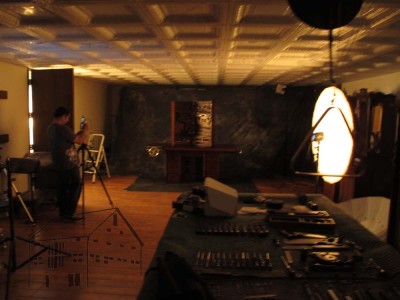
A behind-the-scenes look at how I spent my day today, working with Narayan Nayar and Chris Schwarz wrapping up our penultimate day of photography for my book VIRTUOSO: The Tool Cabinet and Workbench of Henry O. Studley.
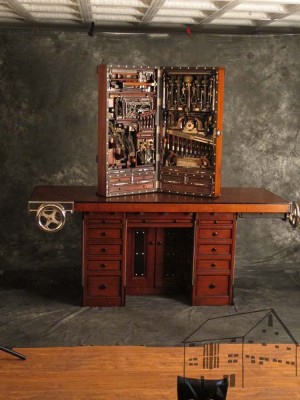
Among the multitude of things that I am and things that I am not, two come clearly to mind in this initial recap of my recent foray into Cincinnati/Covington for Woodworking in America.

One thing I am not is a calligrapher, by that I mean someone whose handwriting is legible to anyone but me. Mine may be to penmanship what Jackson “Jack the Dripper” Pollack is to real painting. On the flip side of that truth is the added reality that I am someone who actually crafts a lot of my words with pen and pencil on a piece of paper. I would be pleased if my handwriting were elegant, but not enough to actually practice and accomplish it.
At WIA since I was going to be signing something approaching a literal ton of To Make As Perfectly As Possible books I wanted to make sure I was using a permanent archival pen for the occasion. A quick ask-about revealed the presence of a stationary and pen store called Appointments just over the river in Cincinnati, and I headed across the Ohio River on the Robeling bridge, itself a delightful stroll on a sunny afternoon.
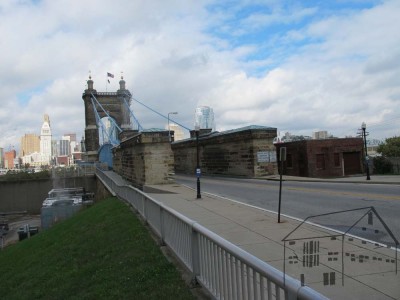
It was at Appointments that I met Douglas Kennedy, a tool geek of the first order. His tools are writing implements. To say that he was interested in writing tools would be like saying I am interested in shellac. While his store did not have the specific tool I was seeking – that was later found at an art and drafting supply store nearby – I nevertheless spent a half hour with Mr. Kennedy looking at and test driving a number of truly wondrous writing tools. It turned out that he had a lot of tools I wanted, and did in fact leave with a couple including a Cross Tech3+ “triple,” a pen body that includes a black stylus for writing, a red stylus for editing, and a 0.5 mm mechanical pencil. In fact, recognizing that I was looking for excellent tools rather than expensive tools he catered to my interests completely. As we parted company I could only think “here was a craftsman fully engaged in the use of fine tools.”
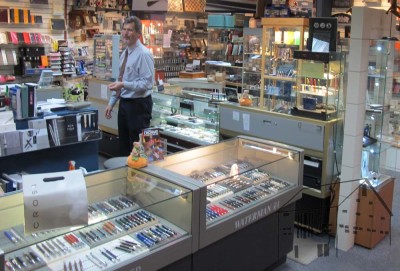
If you are in the Cincinnati area and need counsel on fine writing tools, Douglas Kennedy is the man to see.
As I left Appointments on my way to the art store he told me about, I was walking along the sidewalk and came to the window behind which Gus Miller was crafting hats at the Batsakes Hats shop at Sixth and Main. I was hooked.
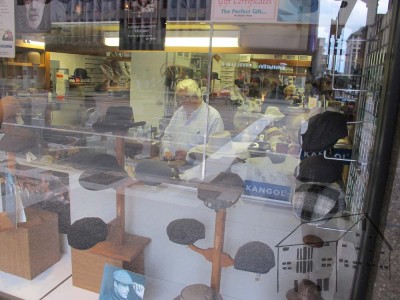
You see, a second thing I am not is a fashionista. On an annual basis I spend literally dozens of seconds purchasing attire, mostly at the local thrift store or on line – I know my body measurements, why should I have to try anything on? – but what I am is a hat guy. The vision of Gus Miller crafting hats and the stacks of inventory in the background compelled me to round the corner and go in. Sure enough, Mr. Miller and his lovely wife had just what I needed, even though I didn’t even know I needed it two minutes before I saw him.

While in the store they showed me not only their inventory but the tools he uses with consummate skill. Another tool geek encountered, but again with a wholely disparate set of tools from my perspective, as he crafts, shapes, and modifies hats for his loyal customer, including this new loyal customer. (Yes, I know that the dictionary says the word is “wholly” but dictionaries are idiotic some times and I refuse to stop using the more rational “wholely” and some day it will lead to a death match conflict with an editor) I walked out the door with a really cool-looking Borsalino “flat” that looks like it was made with my head in mind. It is already my everyday hat. Given Lost Art Press’ proximity to Batsakes the odds are near 100% I will be visiting again.
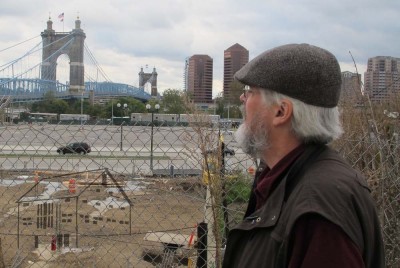
That evening was the gathering of Roubo-istas at the book release party for To Make As Perfectly As Possible as scores of us crammed into an artisan’s pizza place Chris Schwarz knew about.

The fellowship there was almost overwhelmingly delightful as both Deluxe and Standard Editions were distributed to loyal and patient acquisitors, tool geeks all. I was much humbled by the enthusiastic support for our projects, but none more so than when folks like CraigF and TimH took the trouble to drive for hours to attend and congratulate us, even though they would not be attending the WIA conference.

My appreciation for that encouragement cannot be fully articulated in words, even with a really nice pen while wearing a cool hat.
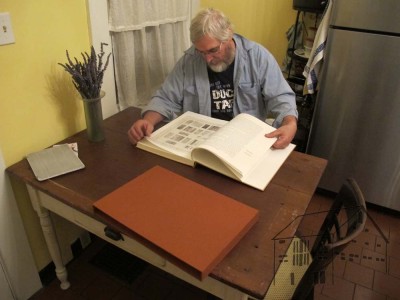
The glazed look of someone who has just driven nine hours and has their first encounter with the real, live, Deluxe Edition of “To Make As Perfectly As Possible: Roubo On Marquetry.”
Almost overwhelming.
Publisher Christopher Schwarz and Editrix Megan Fitzpatrick say it may be the nicest contemporary volume they have ever seen.
They are not wrong.
It’s hard to believe that Sgt. Don’s Bench Boot Camp convened a week ago! Dave returned home Sunday, dragging but elated, and with my schedule of upcoming event preparations I am not sure how much more will get done on Jason’s bench when we head back to “civilization” in a couple days (one great thing about time in the hinterboonies is that we pay less attention to the activities out in the asylum).
Jason has been plagued by a misbehaving back all week, so it has been a constant challenge for him.

As the week continued there was a lot of sawing and pounding as the pieces of the benches were formed and fitted. Dave made great strides as this project was the first of its kind for him, or for Jason for that matter. As with intense projects, even with regular housekeeping the place devolved into near-chaos on a regular basis.
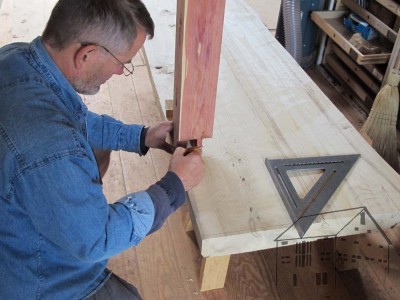
In short order Dave got his double tenons layed out,

the mortises cut and chopped,
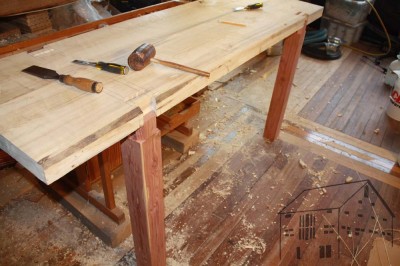
and much to his joy their first test fitting was very positive. Given the top of hackberry and the legs of aromatic red cedar, both sorta spongy, I knew we could whack it all together in the end.
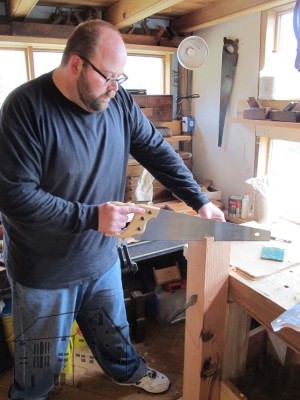
Not to be undone, even though he could stand for only short periods of time, Jason lit into his two Douglas Fir front legs with gusto.
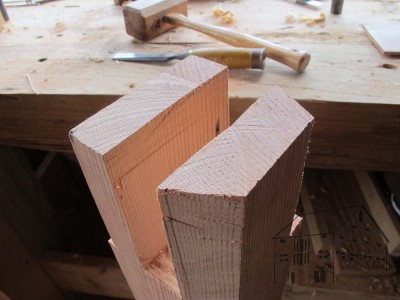
Unfortunately the Douglas Fir stock set aside for the rear legs were just too punky to be useful.
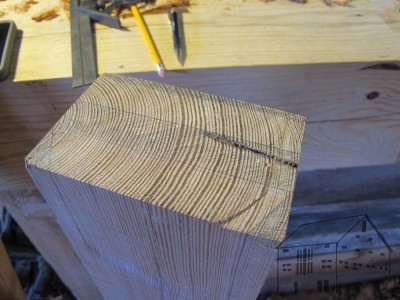
Fortunately I had a pile of 125-year-old superb Southern Yellow Pine timbers and he prepped and made the rear legs from this. Given the age of the wood, it is not surprising that Jason found out how hard and tough vintage SYP can be.
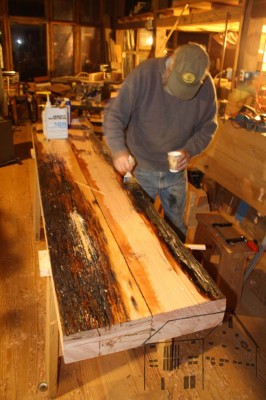
The punkiness of the legs was evident on the underside of the top as well, always a hazard when repurposing salvaged wood. If we removed all of the damage to get down to sound wood we would have had to remove at least an inch, but we liked the nearly 5 inches we had for the top thickness so I chose another route. Instead, I brushed an application of diluted epoxy (~20% acetone) onto the affected areas, and that worked like a charm. It took two days to harden sufficiently. But it consolidated the damaged cellular structure enough to make it firm and sound without turning it into a block of solid brittle plastic.
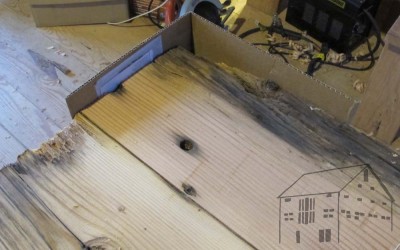
I exploited the properties of epoxy to make a repair at one corner as well, which had a chunk missing due to the same previous deterioration. To cut this off would have cost us nearly a foot of overall length, so we used a technique I have employed with great success when dealing with damaged timbers.
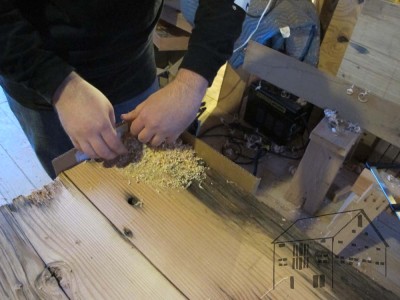
I made a form from a cardboard box and stapled it to the corner, then packed it tightly with wood shavings,

and poured in slightly thinned epoxy (less than 10% acetone) to fill the entire void.

The combination of the wood shavings and the exothermic phenomenon of the epoxy boiling in place aerated the fill, rendering a rigid, well-adhered fill that can be worked with typical woodworking tools.
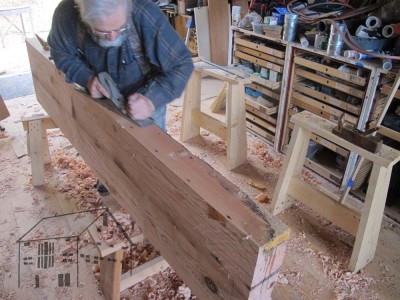
While it does not render a “finished” surface it is easily planed and rasped, certainly adequate for this function and location.
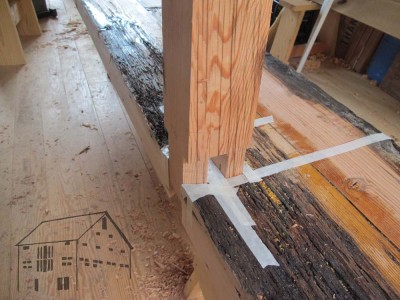
I also employed a technique I’ve used with great success when restoring old timber structures by using tape as my layout lines for cutting joinery. With care it is exceedingly quick and stupid easy.
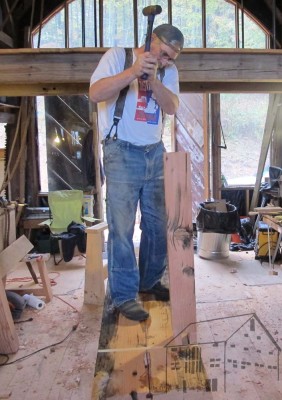
It was here, too, as the cut joints were snug and tight when placed in the mortises.
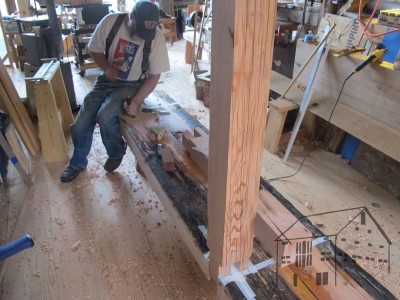
With Jason’s mobility limited I gladly pitched in to get his joinery moving forward wrapped up.
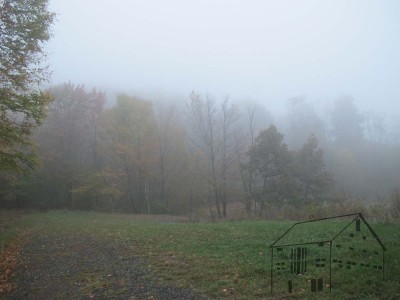
Apropos almost nothing, here are two pictures summarizing the week. The weather was uniformly grim, with heavy misty fog blanketing the valley for several days.
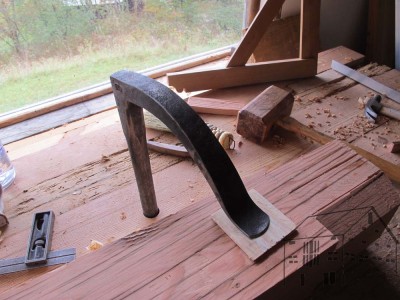
This picture of Peter Ross’ holdfast is just cool.
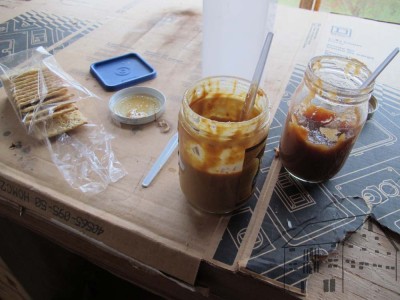
One special treat for Saturday was my checking out for an hour or so to visit our local Sheriff ‘s farm (a woodworker) where they were making fresh apple butter. I returned to the barn with a jar of still-hot preserves and a sleeve of crackers along with a jar of organic peanut butter. This late afternoon snack was all we needed for dinner that night.
As dusk fell Saturday night we were oh-so-close to assembling Dave’s bench that the two of us drove on even after Jason’s back forced him to retire for the night.
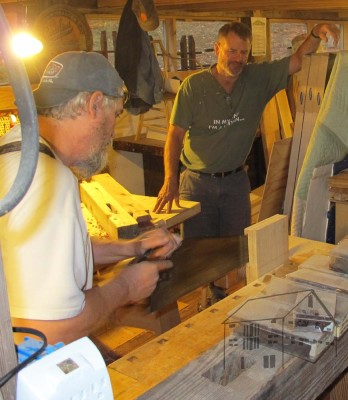
I jumped in to help with the side stretchers, and some time around nine o’clock we fitted, cajoled, clamped, and sledged-hammered the whole thing together.

Even dry and untrimmed, the bench was unwavering in its beefy rigidity. Dave was rightly pleased with the accomplishments of the week as it both stretched his abilities and resulted in a project that has already changed the way he works, and will continue to refine and expand his work from this point forward. I have asked him to contribute an occasional blog post here to recount the new chapter in his artisanry.
Sunday morning we loaded Dave up and I departed first heading off to worship. Jason had a slate of assignments while I was gone, and when I returned later that afternoon he had made good progress. Seriously, having your back acting up robs you of so much power and stamina but he was a trooper.
Tonight frustrated me as one of the legs simply would not go into its mortises, and I cannot yet see any reason why that would be so. I will noodle it in the morning when my brain is more alive and see what I can figure out.

































































Recent Comments